The Smart Home Service Market is estimated to be valued at USD 10.0 billion in 2025 and is projected to reach USD 41.8 billion by 2035, registering a compound annual growth rate (CAGR) of 15.4% over the forecast period.
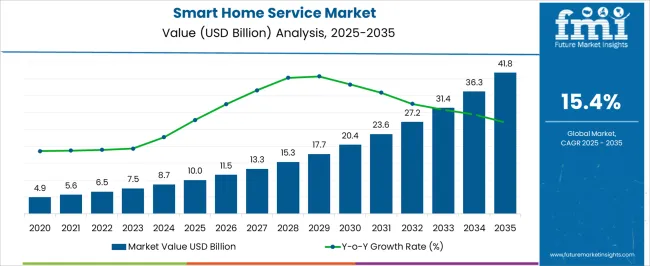
| Metric | Value |
|---|---|
| Smart Home Service Market Estimated Value in (2025 E) | USD 10.0 billion |
| Smart Home Service Market Forecast Value in (2035 F) | USD 41.8 billion |
| Forecast CAGR (2025 to 2035) | 15.4% |
The smart home service market is experiencing rapid expansion as households increasingly adopt connected technologies that enhance convenience, security, and energy efficiency. Rising penetration of high speed internet, growth in IoT enabled devices, and supportive government initiatives for energy conservation are reinforcing adoption trends.
Consumers are demonstrating a strong preference for integrated platforms that provide seamless control of multiple devices through centralized systems. Continuous innovation in AI driven automation, voice assistance, and interoperability standards has further strengthened the market position of smart home services.
Additionally, heightened focus on home safety, data security, and personalized user experiences is accelerating demand across both developed and emerging economies. The outlook for the market remains promising as vendors continue to invest in value added services, cloud connectivity, and tailored solutions that align with evolving consumer lifestyles and sustainability goals.
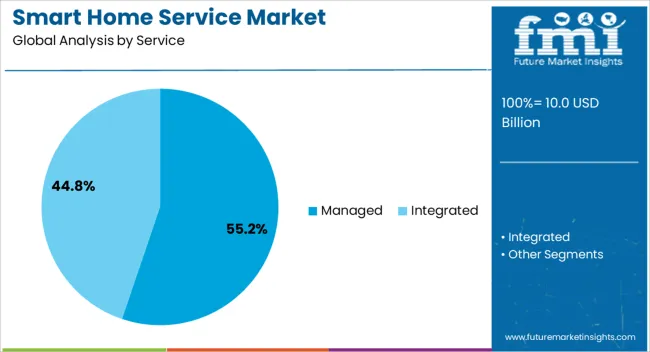
The managed service segment is projected to contribute 55.20% of overall revenue by 2025 within the service category, making it the leading segment. Growth in this area is being fueled by increasing consumer reliance on professional monitoring, remote support, and continuous maintenance for connected home ecosystems.
Managed services provide greater reliability, real time problem resolution, and enhanced customer satisfaction compared to self managed solutions. Service providers have been able to leverage subscription based models, ensuring recurring revenue streams and scalable business models.
Rising consumer awareness about data security and seamless functionality has further amplified adoption of managed services, securing their dominance in the smart home service market.
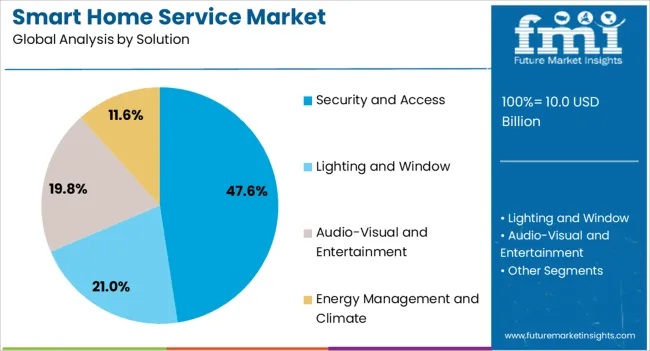
The security and access solution segment is expected to account for 47.60% of total revenue by 2025 within the solution category, establishing it as the most prominent segment. Increasing concerns over residential safety, burglary prevention, and real time surveillance are driving demand for smart locks, video doorbells, and access control systems.
Integration of these solutions with mobile applications and cloud platforms has improved convenience and real time monitoring capabilities for homeowners. The segment has also benefited from technological advancements in biometric authentication and AI powered threat detection.
Growing consumer preference for secure and connected living environments continues to strengthen the leadership of the security and access solution segment in the smart home service market.
According to Future Market Insights, a market research and competitive intelligence provider, the market value of the smart home service market increased at a CAGR of around 15.1% from 2020 to 2025.
Based on service, the integrated service is rapidly affecting the smart home service industry. This segment's revenue is expected to record a CAGR of 16.1% through 2035.
The increasing use of cognitive solutions in smart homes is driving up demand for maintenance and installation services, propelling the industry forward. Furthermore, the growing demand for energy management services is expected to drive market growth. Smart home services have witnessed tremendous improvements in recent years to provide optimal safety and comfort to occupants. As traditional technologies such as open protocols are taking a backseat, market players are keen on launching novel connective technologies and systems to facilitate advanced automation metrics.
These factors are indicative of lucrative growth prospects in the smart home services market during the forecast period. Furthermore, rapid advancements may lead the market towards a value of USD 41.8 billion with a progressive growth rate of 15.4% by 2035.
The increasing need for monitoring and robust security is likely to aid the growth of the smart home services business in the coming years. Smart homes improve entertainment capabilities such as content sharing and aid consumers in operating their entertainment equipment from remote places.
Additionally, the rising demand to reduce energy utility costs due to the adoption of gadgets in residences drives market expansion throughout the forecast period. Furthermore, the widespread use of smart lighting, smart outlets, smart fans, and smart ACs are more likely to drive the demand for smart home services in the coming years. Nonetheless, the high cost of smart home technology, as well as rising worries about privacy and abuse of smart home services, may be averse to industry growth. However, the robust connection provided by smart home services is expected to counteract the adverse impact of market restraints in the coming years.
According to Icontrol Network's 2020 'state of the Smart Home' research, around 46% of respondents claimed that entertainment is a significant component in smart home adoption. As a result, these factors are projected to fuel the growth of the worldwide smart home services industry over the forecast period.
The implementation of building automation components, particularly HVAC systems and renewable energy sources, improves the possibility to increase the energy efficiency quotient of buildings further than intended.
Increasing concerns regarding greenhouse emissions and frequent climatic changes have urged manufacturers to implement BAS (breach and attack system) to smartly monitor and control electricity consumption in residential and commercial complexes.
By integrating these technologies, it is possible to control the thermal settings of centralized heating and cooling systems and improve thermal storage capabilities and electrical characteristics to meet the electricity grid needs.
Apart from this, smart home services potentially manage and control water and gas supply, further correcting any inefficiencies and excess waste. Sensors, sub-meters, and alerting systems detect water and gas leakage, facilitate uninterrupted supply and ensure appropriate consumption of electricity to improve decarbonization capabilities.
Alternatively, BAS can help mitigate unprecedented problems in real time, which in turn creates a more preventive posture in residential and commercial spaces. These solutions can be tailored according to the size and capacity of facilities, helping managers and supervisors to control and provide an uninterrupted supply of electricity, water, and gas.
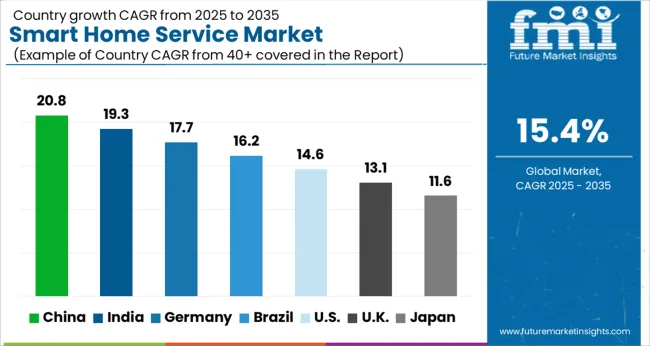
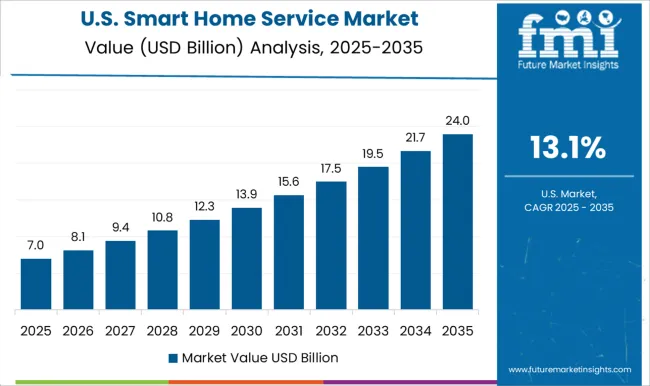
The United States is expected to lead the market, valued at USD 41.8 billion by the end of 2035, with a CAGR of 16.0%. A recent poll conducted in the United States found that safety-focused smart home services are in high demand. Customers are integrating smart home technologies such as smart lighting solutions and energy management services to make their lives easier and more convenient. The North American market benefits from the presence of several key companies, in addition to being an early adopter of modern technologies. The growing demand for modern innovations like intelligent homes, and electronic gadgets, and the increasing incorporation of IoT devices in the United States has resulted in the expansion of the smart home services market.
The markets in the Middle East and Latin America are expected to grow steadily. According to a Ciena study report released in June 2024, more than half of adults in the Kingdom of Saudi Arabia (57%) and the United Arab Emirates (54%) believe the future of the internet is likely to be driven by their desire to become more energy efficient. A huge proportion of people in both countries (94 percent in each) are considering engaging in more virtual activities to reduce their carbon footprint.
The use of smart home systems and consumption control devices is increasing (40 percent in the UAE and 46 percent in the KSA). Metro and edge networks are being asked to meet ever-increasing demand as a result of these key market trends. To become more efficient and reduce energy consumption, the network must, of course, evolve in response to consumer demand.
In this region, rising demand for connected home services is supplementing industry growth. Additionally, the demands for emerging technology, the desire for lifestyle up-gradation, and the popularity of voice technology in emerging markets are anticipated to surge the development of smart home services. The region's key players are concentrating their efforts on collaborating with other well-known companies to develop and deploy innovative smart home products. For example, Vivint Smart Home, Inc. and Mosaic Acquisition Corp. announced a merger in January 2024. The merger's goal was to turn the organization into a publicly traded company while also improving the smart home platform.
Existing industrial and service companies are integrating with IT to create new value while also influencing industry and service structure. By integrating smart concepts through IT convergence, it is possible to deliver integrated services such as home environment, transportation, online service, and healthcare.
As a result of information technology convergence technologies, the smart home sector is evolving in a variety of ways. Smart technology can be used in any industry to provide integrated services by leveraging previously unavailable services or partnerships. Smart home services are constantly evolving as a result of the advancement of ICT and the proliferation of various IoT devices. Smart home services can provide a variety of services through a single device.
As more people work or study from home, a variety of IoT devices are expected to make work and study more pleasant during and after the epidemic. The home now has a special meaning for consumers in the post-Covid era, with space for business, recreation, and study. As a result, families are increasingly seeking integrated solutions that improve their quality of life.
These factors have resulted in a massive industry for smart home services, which is anticipated to drive market growth. Schneider Electric, for example, and Livspace, a home interior and remodeling platform, agreed to collaborate in August 2024.
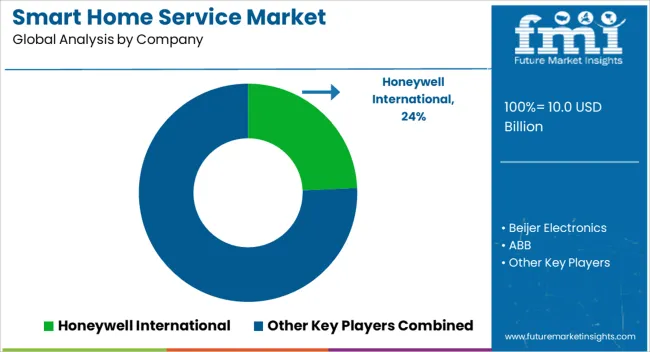
The market for smart home services is neither fragmented nor consolidated. The companies are developing business strategies that reflect an increased emphasis on expanding their existing global distributor networks. To expand their reach and maintain their market position, the key players employ strategies such as product innovation, mergers, and acquisitions.
| Attribute | Details |
|---|---|
| Forecast Period | 2025 to 2035 |
| Historical Data Available for | 2020 to 2025 |
| Market Analysis | USD billion for Value |
| Key Countries Covered | United States, Canada, Germany, United Kingdom, France, Italy, Spain, Russia, China, Japan, South Korea, India, Thailand, Malaysia, Indonesia, Australia, New Zealand, GCC Countries, Türkiye, Northern Africa, and South Africa |
| Key Segments Covered | By Services, By Solution, Region |
| Key Companies Profiled | Honeywell International; Beijer Electronics; ABB; Siemens AG; Johnson Controls; Schneider Electric; General Electric; Legrand; Lutron Electronics Co; Control4 Corporation |
| Report Coverage | Market Forecast, Company Share Analysis, Competition Intelligence, DROT Analysis, Market Dynamics and Challenges, and Strategic Growth Initiatives |
| Customization & Pricing | Available upon Request |
The global smart home service market is estimated to be valued at USD 10.0 billion in 2025.
The market size for the smart home service market is projected to reach USD 41.8 billion by 2035.
The smart home service market is expected to grow at a 15.4% CAGR between 2025 and 2035.
The key product types in smart home service market are managed and integrated.
In terms of solution, security and access segment to command 47.6% share in the smart home service market in 2025.






Our Research Products

The "Full Research Suite" delivers actionable market intel, deep dives on markets or technologies, so clients act faster, cut risk, and unlock growth.

The Leaderboard benchmarks and ranks top vendors, classifying them as Established Leaders, Leading Challengers, or Disruptors & Challengers.

Locates where complements amplify value and substitutes erode it, forecasting net impact by horizon

We deliver granular, decision-grade intel: market sizing, 5-year forecasts, pricing, adoption, usage, revenue, and operational KPIs—plus competitor tracking, regulation, and value chains—across 60 countries broadly.

Spot the shifts before they hit your P&L. We track inflection points, adoption curves, pricing moves, and ecosystem plays to show where demand is heading, why it is changing, and what to do next across high-growth markets and disruptive tech

Real-time reads of user behavior. We track shifting priorities, perceptions of today’s and next-gen services, and provider experience, then pace how fast tech moves from trial to adoption, blending buyer, consumer, and channel inputs with social signals (#WhySwitch, #UX).

Partner with our analyst team to build a custom report designed around your business priorities. From analysing market trends to assessing competitors or crafting bespoke datasets, we tailor insights to your needs.
Supplier Intelligence
Discovery & Profiling
Capacity & Footprint
Performance & Risk
Compliance & Governance
Commercial Readiness
Who Supplies Whom
Scorecards & Shortlists
Playbooks & Docs
Category Intelligence
Definition & Scope
Demand & Use Cases
Cost Drivers
Market Structure
Supply Chain Map
Trade & Policy
Operating Norms
Deliverables
Buyer Intelligence
Account Basics
Spend & Scope
Procurement Model
Vendor Requirements
Terms & Policies
Entry Strategy
Pain Points & Triggers
Outputs
Pricing Analysis
Benchmarks
Trends
Should-Cost
Indexation
Landed Cost
Commercial Terms
Deliverables
Brand Analysis
Positioning & Value Prop
Share & Presence
Customer Evidence
Go-to-Market
Digital & Reputation
Compliance & Trust
KPIs & Gaps
Outputs
Full Research Suite comprises of:
Market outlook & trends analysis
Interviews & case studies
Strategic recommendations
Vendor profiles & capabilities analysis
5-year forecasts
8 regions and 60+ country-level data splits
Market segment data splits
12 months of continuous data updates
DELIVERED AS:
PDF EXCEL ONLINE
Smart Meeting Pod Market Size and Share Forecast Outlook 2025 to 2035
Smart Electrogastrogram Recorder Market Size and Share Forecast Outlook 2025 to 2035
Smart Aerial Work Robots Market Size and Share Forecast Outlook 2025 to 2035
Smart Bladder Scanner Market Size and Share Forecast Outlook 2025 to 2035
Smart School Bus Platform Market Size and Share Forecast Outlook 2025 to 2035
Smart Bus Platform Market Size and Share Forecast Outlook 2025 to 2035
Smart Vision Processing Chips Market Size and Share Forecast Outlook 2025 to 2035
Smart Touch Screen Scale Market Size and Share Forecast Outlook 2025 to 2035
Smart Magnetic Drive Conveyor System Market Size and Share Forecast Outlook 2025 to 2035
Smart Wheelchair market Size and Share Forecast Outlook 2025 to 2035
Smart Mining Technologies Market Size and Share Forecast Outlook 2025 to 2035
Smart Parking Market Size and Share Forecast Outlook 2025 to 2035
Smart Digital Valve Positioner Market Forecast and Outlook 2025 to 2035
Smart Card IC Market Size and Share Forecast Outlook 2025 to 2035
Smart-Tag Inlay Inserters Market Analysis - Size and Share Forecast Outlook 2025 to 2035
Smart TV Market Forecast and Outlook 2025 to 2035
Smart/AI Toy Market Size and Share Forecast Outlook 2025 to 2035
Smart Locks Market Size and Share Forecast Outlook 2025 to 2035
Smart Sprinkler Controller Market Size and Share Forecast Outlook 2025 to 2035
Smart Indoor Gardening System Market Size and Share Forecast Outlook 2025 to 2035

Thank you!
You will receive an email from our Business Development Manager. Please be sure to check your SPAM/JUNK folder too.
Chat With
MaRIA